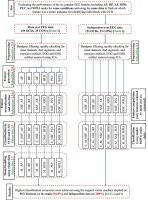脑电测量在强迫症中的应用
IF 4.9
2区 医学
Q1 ENGINEERING, BIOMEDICAL
引用次数: 0
摘要
背景强迫症(OCD)是一种潜在的严重精神障碍,影响着全球 1-2% 的人口。强迫症患者会出现无法控制和反复出现的想法(强迫症),并可能感到需要重复行为(强迫症)。在脑电图研究中,已经对强迫症诊断能力的许多不同特征进行了调查。为了解决这个问题,我们采用了六种流行的静息态脑电图特征,包括绝对和相对功率、锁相值(PLV)、加权相位滞后指数(WPLI)、近似熵和樋口分形维度,以找出在相同条件和数据下哪种特征能更好地区分强迫症和健康对照组(CON)。所有生成的特征均使用从 233 名伊朗健康人中计算得出的平均值和标准偏差进行归一化处理。然后,选出最有信息量的脑电图特征,将 39 名强迫症患者与年龄、手型和性别匹配的 39 名健康对照者区分开来,并将其输入分类过程。此外,还使用了一个独立的脑电图数据集,其中包括 23 名强迫症患者和 23 名强迫症患者,以研究结果的一致性。使用支持向量机对主数据集(94.8%)和独立数据集(100%)的 PLV 特征进行分类,分类准确率最高。本文章由计算机程序翻译,如有差异,请以英文原文为准。

The utility of electroencephalographic measures in obsession compulsion disorder
Background
Obsessive-compulsive disorder (OCD) is a potentially serious mental disorder that affects 1–2% of the world population. The OCD patients experience uncontrollable, and recurring thoughts (obsessions), and may feel a need to repeat behaviors (compulsions). In EEG studies, many different features have been investigated regarding their OCD diagnosis capability. However, there is no OCD study evaluating different EEG features with the same conditions and data.
Methods
To address the problem, we employed six popular resting-state EEG features, including absolute and relative power, Phase locking value (PLV), Weighted phase lag index (WPLI), approximate entropy, and Higuchi’s fractal dimension, to find out which feature can better discriminate OCDs from healthy controls (CON) under the same conditions and data. All the generated features were normalized using mean and standard deviation of values, calculated from 233 Iranian healthy people. After that, the most informative EEG features, discriminating 39 OCD individuals from age, handedness, and gender-matched, 39 CON were selected and entered into the classification process. In addition, an independent EEG dataset including 23 OCDs and 23 CONs was also used to investigate the consistency of the results.
Results
As expected, most of the significant differences were observed at the high frequency bands in Beta I-IV, and Gamma bands. The highest classification accuracies were achieved using the support vector machine applied on the PLV features of the main (94.8 %) and independent dataset (100 %)
Conclusions
These findings indicate that functional connectivity-based (PLV) features have a good potential to be used as a biomarker of OCD.
求助全文
通过发布文献求助,成功后即可免费获取论文全文。
去求助
来源期刊

Biomedical Signal Processing and Control
工程技术-工程:生物医学
CiteScore
9.80
自引率
13.70%
发文量
822
审稿时长
4 months
期刊介绍:
Biomedical Signal Processing and Control aims to provide a cross-disciplinary international forum for the interchange of information on research in the measurement and analysis of signals and images in clinical medicine and the biological sciences. Emphasis is placed on contributions dealing with the practical, applications-led research on the use of methods and devices in clinical diagnosis, patient monitoring and management.
Biomedical Signal Processing and Control reflects the main areas in which these methods are being used and developed at the interface of both engineering and clinical science. The scope of the journal is defined to include relevant review papers, technical notes, short communications and letters. Tutorial papers and special issues will also be published.
 求助内容:
求助内容: 应助结果提醒方式:
应助结果提醒方式:


